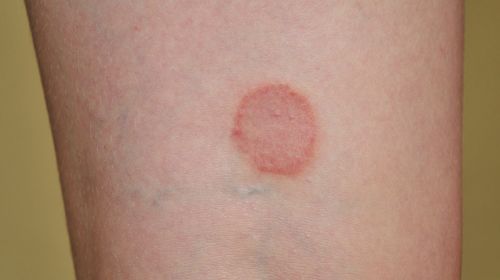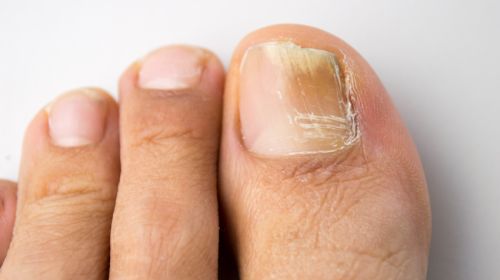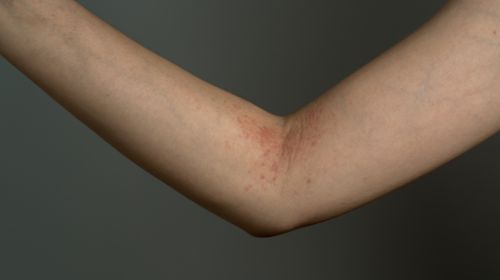Author: Monika Preuk, medical author
Last update:
February 27, 2020
Scalp, face, hand, foot or genital area: skin fungus can appear anywhere. It is stubborn and annoying, but mostly harmless. From what symptoms you can recognize skin fungus, what treatment works and whether home remedies are recommended to get rid of the skin disease.
- Typical for skin fungus are red, blotchy spots that scale.
- © iStock.com/alejandrophotography
Overview of article content
What is skin fungus?
Skin fungus is medically referred to as dermatology or tinea. It can affect all areas of the skin and is probably the most common skin disease. Up to a third of Germans have had experience with this. The infection can attack the skin and mucous membranes, but also the nails. Depending on the area in which the skin fungus breaks out, the disease is described differently:
Tinea pedis: on the feet (the most common form of skin fungus)
Tinea capitis: on the scalp
Tinea barbae (beard lichen): in the beard region in men
Tinea faciei: on the face
Tinea manuum: by the hand
Inguinal tinea: from the genital area to the anus and also on the thigh and in men on the testicles
Vaginal fungus: in the female genital area (in contrast to tinea inguinalis due to another pathogen)
The skin disease can be limited to the surface of the skin. Then the doctor talks about tinea superficialis. However, sometimes the infection can go deeper, this is called tinea profunda. This form is rarer and affects, for example, tinea barbae – then the pathogens spread along the hair roots.
There are two main causes of skin fungus
Triggers for skin fungus are fungi, more precisely their spores, which are comparable to the seeds of a plant. In fact, these mushrooms are living organisms that can be compared to plants.
There are two large groups of skin fungi that can make you sick:
Dermatophytes (filamentous fungi): There are different types of these fungi (Trichophyton, Microsporum canis and Epidermophyton), which mainly affect the scalp, face and hands. Filamentous mushrooms only settle on the skin.
Yeasts (sprout mushrooms): Among its 150 forms, the best known yeast is Candida albicans. It not only settles on the skin – like the filamentous fungi – but mainly affects mucous membranes such as the vagina, penis and testicles and can also lead to oral thrush in the mouth. In very rare cases, a yeast infection can spread further in the body and lead to blood poisoning.
The third and rarest group of causes of a skin infection are molds that are inhaled through the air.
Symptoms: how to recognize skin fungus?
Depending on which pathogens trigger the skin fungus, the signs may differ:
For Filamentous mushrooms speak symptoms such as skin blisters and red, flat areas (sometimes with a sharply defined edge) that flake. These skin changes can only be a few millimeters in diameter or spread over large areas – for example, the entire hand.
For an infection with Yeasts indicates above all the massive itching that comes from small, red skin areas. However, if you give in to the itching, you risk an additional infection with bacteria. In addition, there is a risk that the fungal infection will spread inwards.
Lead against Molds skin changes less often and especially threaten the lungs. However, they can also cause an allergic shock. The signs of a mold infection primarily affect the entire body. However, mold infections are very rare, and immunocompromised individuals are particularly at risk.
Infection with skin fungus over humans and animals
With mold, you can only become infected through moldy food and contaminated living spaces. In filamentous and yeast fungi – the two most common triggers of skin fungus – you can be infected directly by contact with the infected skin of an infected person. There is also an indirect risk of infection, for example through shared objects. These are, for example, towels, laundry and, in the case of athlete's foot, walking over contaminated soil.
Animals are also a source of infection, for example cats and dogs, but also horses and cattle. This is indicated by dermatologists from the Aachen clinic. The animals can mainly transmit Microsporum canis, a filamentous fungus that triggers tinea capitis, among other things.
Risk factors for skin fungus – obesity also plays a role
The local defense system usually copes well with skin fungi so that there is no onset of a disease. But certain factors favor the settlement and multiplication of the skin fungi. First and foremost, this is a warm, moist skin environment. Heavy sweating or swimming can mean risk factors for skin fungus.
Other beneficial factors are:
Overweight – often people sweat more and the pathogens can settle in the moist skin folds.
Diabetes – the metabolism also changes the skin flora and becomes susceptible to skin diseases.
Blood circulation disorders of the skin – therefore smoking is also considered a risk factor for skin fungus, because it worsens the blood circulation and also weakens the immune system.
Immunodeficiency – skin fungus often occurs after a strong infection if the immune system has not yet recovered. In addition, in all – for example, HIV or an autoimmune disease – immunocompromised patients who are treated with immunosuppressive agents.
Skin fungus is not always harmless
In general, skin fungus is not very worrying for medical professionals if only a small area is affected and the symptoms are kept within limits. Nevertheless, it makes sense to have a dermatologist clarify skin changes and itching that persists for more than a week.
If left untreated, a skin fungal infection can sometimes become chronic or spread internally. In addition, new, previously unknown forms of mushrooms are discovered again and again. Experts have recently warned of a special yeast that is immune to conventional antifungal medication and, in the worst case, can be fatal. The fungus is called Candida auris and most recently triggered an infection wave with 50 cases in a London hospital.
Diagnosis of skin fungus by the doctor
The first point of contact for suspected skin fungus is the dermatologist. If the symptoms concern the genital area, the gynecologist or urologist can be consulted. The specialist often recognizes from the inspection of the skin changes that skin fungus is probably present.
With a quick test that is rubbed over a diseased area, the skin fungus can be recognized in a few seconds. A smear or a small tissue sample that is placed on a carrier medium and only produces a result after a few days is often no longer necessary.
Another possibility is the light examination with short-wave light (WoodLight, black light), with which certain fungi on the skin can be identified with a glance through fluorescence.
Ointments, shampoo and co .: the treatment of skin fungus
In most cases, the doctor advises a local (topical) antifungal when treating skin fungus. On the one hand, these drugs prevent the fungi from multiplying, on the other hand, they kill the spores. There are low-dose antifungals available for sale as an ointment, spray, lotion or shampoo. The following active ingredients are frequently used:
- Clotrimazole
- Nystatin
- Miconazole
The doctor prescribes tablets for pronounced fungal diseases and for infestation of internal organs. The effect of these antifungals therefore takes place over the entire body (systemically). In general, anti-mycotics are usually so-called broad-spectrum antifungals – medicines – that work against a whole group of fungus forms.
Treat skin fungus yourself – the most important tips
Even if many antifungals are available without a prescription, you should clarify treatment with a doctor. He can match the agent to the exact pathogen. For those who have had a skin fungal infection, or if the disease is very mild, self-treatment with over-the-counter antifungals can be an option.
The most important measure in the treatment of skin fungus is: Do not stop treatment early if the symptoms have improved. The skin fungus often appears to have disappeared after two to three days. The itching no longer exists and the skin looks normal again. However, remaining tiny spores can activate after stopping treatment and cause skin fungus again. Therefore, local antifungals should generally be used for a further two weeks after the symptoms have subsided (please read the package leaflet).
In addition to regular treatment with ointment, lotion or spray, embarrassing hygiene is also important – i.e. change the laundry worn on the diseased skin daily and wash the laundry at at least 60 degrees. Other tips:
Gently cleanse the skin (with washing syndets, i.e. soap-free washing items from the pharmacy).
Keep the skin dry. Because moisture forms an ideal breeding ground for all skin fungi.
Three home remedies for skin fungus
There are also a number of home remedies and tricks to help treat symptoms of skin fungus:
- Dab with apple cider vinegar
- Rub with garlic
- Spray on or dab with tea tree oil
In fact, all of these measures are suitable to reduce the itching. However, there are currently no scientifically sound studies that prove the definitive effects of these home remedies for the fungus. The skin fungus is not killed by these precautions, it can always come back and become chronic. In addition, the use of such home remedies on mucous membranes is not recommended because it can cause severe irritation. Better: let the doctor clarify the suspicious area of the skin and treat it with antifungals.


